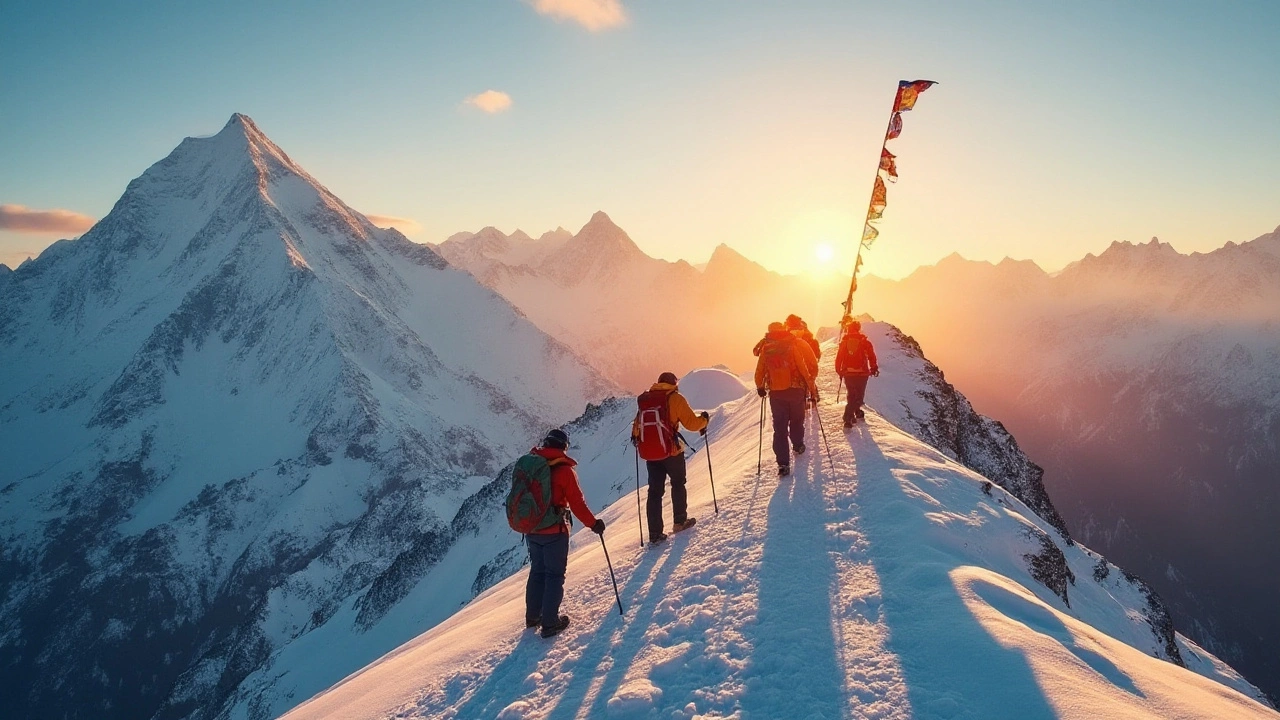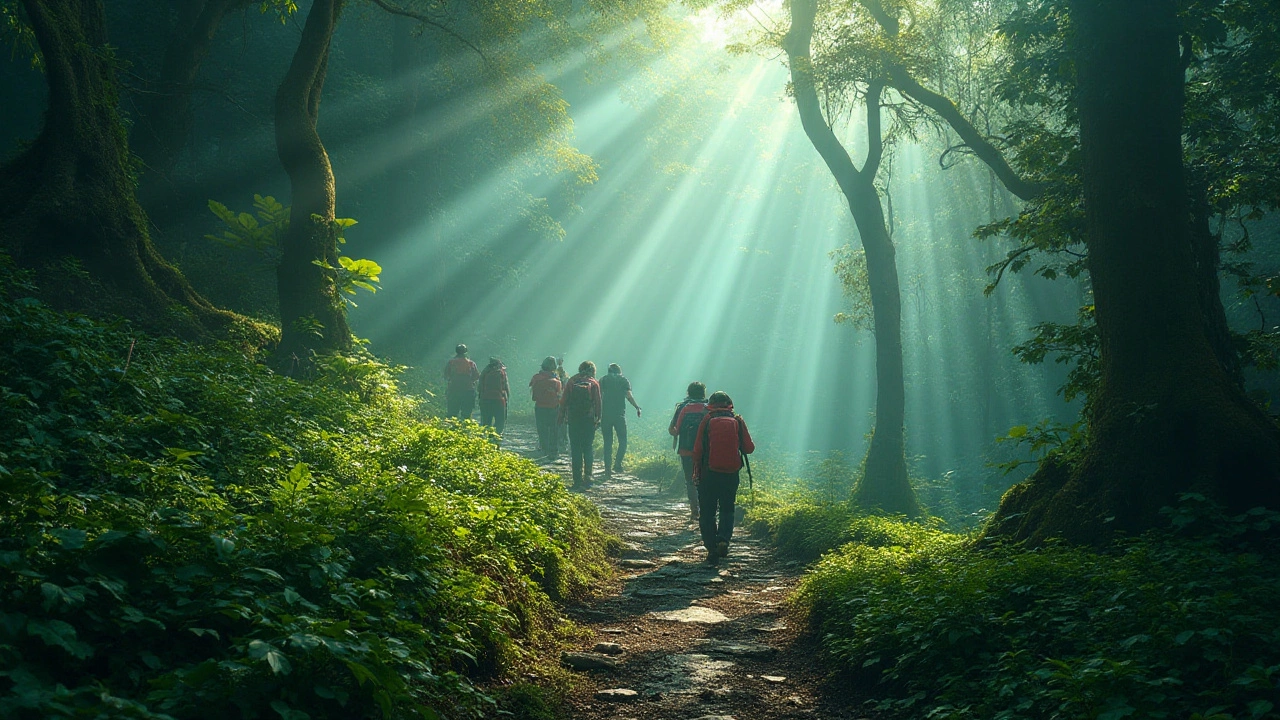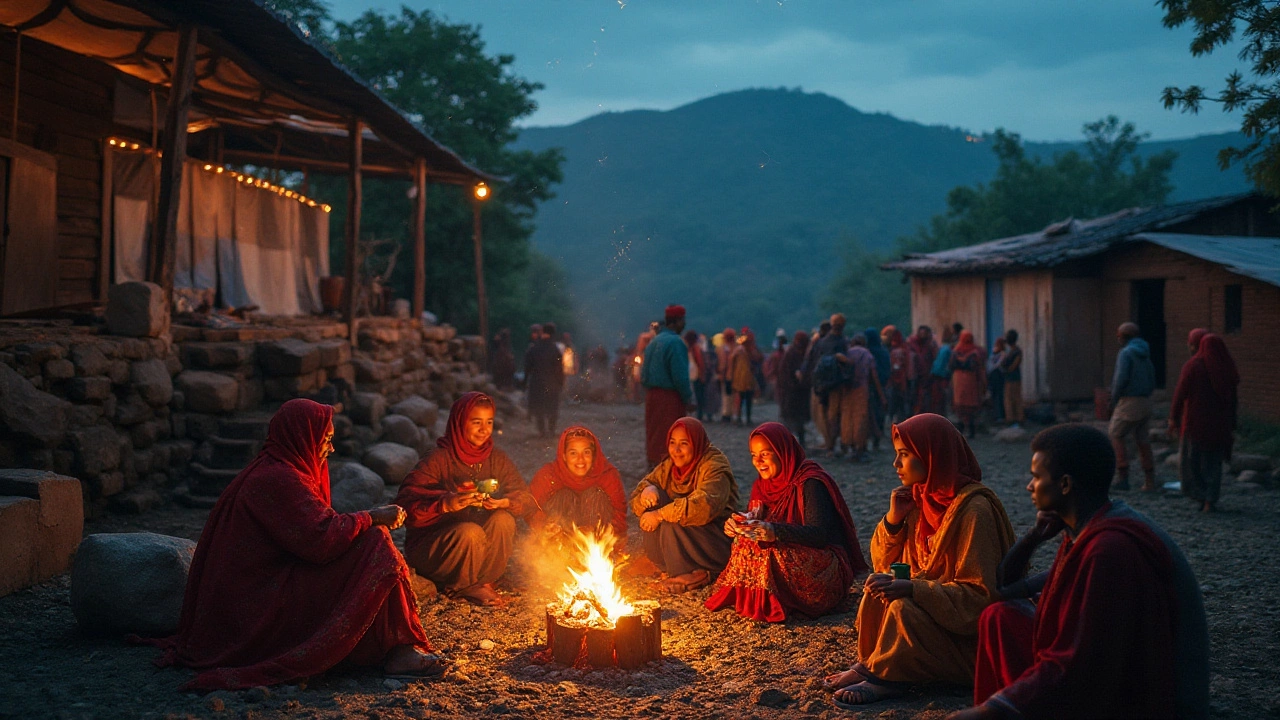Discover India's Top Trekking Destinations for Adventurous Hikers
 Jan, 13 2025
Jan, 13 2025
When it comes to breathtaking landscapes and diverse environments, India stands out as a treasure trove for hikers and adventure seekers. From the highest mountain ranges in the north to the rich biodiversity of the south, there's a path for every kind of trekker. The lush valleys, ascending trails, and the chance to experience unique cultures make India a fascinating spot to explore on foot.
Whether you're traversing the rugged Majestic Himalayan trails or wandering through the serene paths of the Western Ghats, each journey offers its own set of remarkable views and encounters. Embarking on a trekking expedition here means more than just a physical challenge; it invites you to delve into the soul of this multifaceted nation. Let us dive deeper into what makes India's trekking routes not just popular, but a dream destination for hikers worldwide.
- The Majestic Himalayan Trails
- Exploring the Western Ghats
- Cultural Encounters on the Trails
- Preparing for Your Trekking Adventure
- Tips for a Safe and Enjoyable Hike
The Majestic Himalayan Trails
The Himalayas are undeniably a crown jewel for hikers veering into India. Encompassing over 1,500 miles across five countries, the Indian region of the Himalayas is draped in mystique, offering trails that not only challenge your physical limits but also mesmerize your senses. From the state of Himachal Pradesh to Uttarakhand and into the northeastern realms, the variety and splendor of these trails beckon adventurers from across the globe. Imagine the crisp mountain air, the distant bells from remote monasteries, and the vibrant prayer flags leading the way as you journey through some of the highest places on Earth. The grandeur of the mountains is coupled with the spiritual aura that the Himalayas exude, making each trek not only a challenge but also a transformative experience.
One cannot talk about the Himalayan trails without mentioning the storied trek to the Roopkund Lake. Known famously for the human skeletal remains scattered around its banks, Roopkund has fascinated both hikers and researchers. The trail, set at an altitude of approximately 16,000 feet, navigates through alpine meadows, dense forests, and breathtaking ridge tops. Also, the revered Chadar Trek, translating to "Frozen River Trek," offers an experience like no other. Walking over the frozen Zanskar River, with temperatures sometimes plummeting below -30°C, takes endurance and meticulous preparation, highlighting the unique challenges the Himalayas present to even seasoned hikers.
Adding to the allure of these Himalayan hikes is the chance to witness the confluence of ancient cultures and nature's fierce beauty. The Himalayas are home to numerous communities that thrive in the mountainous terrains, each with their distinct traditions and way of life. The village of Malana, claiming to be one of the oldest democracies, beckons with its rich history and customs. When trekking through such regions, you're not only navigating rugged landscapes but also traversing through tales of heritage and the resilience of human spirit. As said by seasoned trekker and author, Stephen Bezruchka,
"The great thing about the Himalayas is that the park rules cease to exist; you find and rediscover yourself in its embrace."
Adventurers drawn to the Himalayas should remember that preparation is as crucial as the journey itself. Weather can be unpredictable, necessitating careful planning regarding gear, clothing, and sustenance. Travel experts often recommend undertaking treks during specific windows to avoid the monsoons or harsh winters. Additionally, acclimatization plays a significant role in elevating one's trek experience, as altitude sickness is a genuine concern. Ensuring you’re physically and mentally prepared for what can easily be an arduous expedition is key to a successful adventure among the Indian Himalayas, making it an essential aspect for any trekking enthusiast to plan thoroughly. To help visualize some of the stunning sites one might encounter, consider the statistics: some areas boast over 500 species of birds and a similar diversity in flora, sure to delight those with an affinity for nature’s grandeur.
Exploring the Western Ghats
The Western Ghats, stretching over 1,600 kilometers through six states, are not just a UNESCO World Heritage site; they are a symphony of nature, waiting to be experienced by avid trekkers. This mountain range, older than even the Himalayas, is shrouded in mystique and unparalleled biodiversity. Home to a rich tapestry of flora and fauna, it boasts over 7,825 flowering plants, 139 mammal species, 508 bird species, and more than 179 amphibian species. As you lace up your hiking boots, prepare to be wooed by the whispers of the ancient trees, the cherubic cheer of endemic birds, and the awe-inspiring vistas that change with every bend in the trail.
One of the jewels of the Western Ghats is the awe-inspiring Mullayanagiri, Karnataka's highest peak. Rising 1,930 meters, this trek reveals a mesmerizing combination of verdant coffee plantations, thick shola forests, and rolling grasslands. As you ascend, the mist plays hide and seek, wrapping the path in serene mystery. Another treasure waiting to be explored is the tough yet gratifying trek to Kudremukh. Here, the rugged terrain offers a glimpse of the Western Ghats’ raw, untamed beauty, with highlights being the dense rainforest and panoramic views of majestic valleys below. For those interested in cultural treks, Agumbe is known as the 'Cherrapunji of the South' and boasts an epic trek that leads to ancient temples nestled within the verdant hills. It’s the perfect combination of hiking and heritage.
Ever wondered about the ecological significance of these peaks? The Western Ghats are critical for India's climate as they intercept monsoon rains, making the region one of the most crucial watersheds in the country. Waterfalls galore like Jog Falls and Athirapally Falls erupt from its hillsides, forming lifeline rivers that nourish the vast communities below. In a
report by The Hindu, ecologist Prachi Mehta reflects, "The Western Ghats, with their complex bio-network, hold the key to understanding climate resilience, a key factor in conserving India's environmental health." The trails thus serve as more than just paths for trekkers; they’re journeys through natural heritage corridors.
While exploring the Western Ghats, trekkers must prepare for not just the physical challenges of steep climbs and meandering pathways, but also the weather, which changes drastically depending on altitude and season. It is crucial to carry adequate rain gear, especially given the unpredictable monsoon showers that often sweep the lands without warning. A good trekking kit also includes essentials like hydrating fluids, energy bars, and a digital compass. These peaks have long been favorite hauntings for trekking enthusiasts, and for very good reason. With every hike, the Western Ghats gives back more than it takes.
For adventure travelers, exploring these ancient mountains is like flipping through a geological history book written in swirling green ink. The stories told by the rustling leaves and the echoing calls of howler monkeys create an experience that is as engaging as it is enlightening. As you trek through these rugged trails, remember to leave nothing but footprints and take nothing but mesmerizing memories. The Western Ghats invites you to be a part of its legacy, enticing explorers with promises of discovery and the thrill of the unexplored. With trails catering to all skill levels, from novice hikers to seasoned trekkers, it’s a place where adventure finds its true calling, and the spirit of exploration never withers.

Cultural Encounters on the Trails
As you embark on a trekking adventure through India's varied landscapes, you are bound to encounter the fascinating cultures that thrive along these paths. Many trails pass through remote villages where you can get a glimpse of rural life, far removed from the bustling cityscapes that often characterize modern India. In these villages, time seems to follow its own rhythm, unhurried and harmonious with nature. You'll discover communities deeply connected to their ancestral roots, offering a unique opportunity to experience local customs and traditions firsthand.
In the northern regions, like the Himalayas, many trails pass through small hamlets inhabited by ethnic groups such as the Ladakhis and the Gaddi shepherds. Each of these communities has maintained its distinct identity over the centuries. The Tibetan Buddhist culture prevalent in these areas is evident in the colorful prayer flags fluttering in the wind and the ancient monasteries perched on hilltops. Travelers often report a sense of tranquility and a spiritual aura that these places seem to exude. As the Dalai Lama once said,
"Once a year, go someplace you've never been before."And what better place to find such spiritual and cultural serenity than on these trails?
The Rich Heritage of the Western Ghats
Moving towards the lush forests of the Western Ghats, you'll encounter tribes such as the Todas and the Badagas, each with unique heritage and lifestyles. These indigenous groups have lived here for generations, coexisting harmoniously with the environment. Their knowledge of local flora and fauna is remarkable, and they often share stories of how their ancestors lived in tandem with nature, preserving its resources for future generations. It's not only the human culture that impresses but also the incredible biodiversity. With the Western Ghats being a UNESCO World Heritage site, the blend of natural beauty and cultural richness makes each step feel like a walk through history.
While detailing cultural nuances, one cannot ignore the role played by local cuisines. Each region boasts its unique flavors, influenced by the geography and resources available. In the north, you might be served warm bowls of thukpa and steaming momos. As you trek southward, tasting the spicy curries and coconut-rich dishes becomes an essential part of the journey. Eating locally is not only a delight for the taste buds but also a means to understand more deeply the relationship between culture and environment. This pleasant aroma of freshly prepared local delicacies provides trekkers a taste of hospitality that is as warming as it is humbling.
One cannot undervalue the hospitality extended by these communities to visitors. Despite their often modest means, the people you meet along these trails will likely greet you with a warmth and generosity that leaves a lasting impression. Such interactions frequently lead to stories that hikers cherish long after their journeys end. While language barriers might exist, smiles and shared laughter break through any communication walls, leaving behind memories colored with humanity's universal gestures.
Preparing for Your Trekking Adventure
Embarking on a trekking adventure in India requires careful planning and preparation to ensure a safe and enjoyable experience. The diverse terrains and unpredictable weather conditions present unique challenges that demand a thoughtful approach. Start by researching the specific India trekking trails you intend to explore. Whether it's the famous Annapurna Circuit, the mystical Valley of Flowers, or the challenging Chadar Trek, understanding the peculiarities of each trail contributes significantly to a successful journey. Look for insights from fellow trekkers who have previously completed the trek, as their firsthand experiences offer valuable advice on the demands and highlights of the route.
Physical fitness is crucial for enduring long days of hiking, steep ascents, and potential altitude sickness. Begin your fitness regime at least a few months before your departure by incorporating cardiovascular exercises, strength training, and flexibility workouts. Activities like running, cycling, and yoga can help build endurance, while squats and lunges fortify leg muscles essential for treacherous trails. Train with a backpack that matches the weight you intend to carry, allowing your body to adapt to the load and reduce the risk of injury. Never underestimate the power of a well-prepared body in conquering hiking destinations.
While geographical research and physical preparation are essential, the selection of appropriate gear is equally vital. Opt for waterproof and durable trekking boots that provide ample ankle support, as they are your most valuable asset on uneven paths. Dress in layers to adapt to weather fluctuations, incorporating moisture-wicking base layers and insulated outerwear. Packing light is often advised; however, carrying crucial equipment such as a reliable tent, a sleeping bag suitable for expected temperatures, and a portable water purifier can make the difference between comfort and hardship on the trail. A comprehensive first-aid kit equipped with altitude sickness medication, along with a multi-tool and a flashlight, could prove invaluable during unforeseen situations.
"The mountains are calling, and I must go." - John Muir
Understanding the cultural context of the regions you traverse is also a part of preparation. India is a melting pot of diverse cultures, languages, and beliefs, and showing respect and understanding is crucial, especially when passing through remote villages. Equip yourself with some basic phrases in the local language, as it not only helps in emergencies but also fosters goodwill and enriches your travel experience. Familiarize yourself with local customs and traditions to avoid unintentional disrespect, as cultural sensitivity enhances the journey's spiritual aspect. A friendly demeanor and openness to learn can open doors to unique cultural exchanges that enrich the soul.
Lastly, never underestimate the importance of permits and regulations. Many popular trekking spots in India require official permits, and regulations may vary depending on environmental concerns and seasonal factors. Ensure you've researched and acquired the necessary permits well in advance to avoid last-minute complications. Consider hiring local guides or porters if unfamiliar with the region, as their expertise can navigate unexpected challenges and enhance your understanding of the landscape's ecology and history.

Tips for a Safe and Enjoyable Hike
Setting off on a trekking adventure in India promises an immersive experience amid striking landscapes and cultural richness. Even so, preparation and awareness are key to ensuring not only that the journey is enjoyable but also that it's safe. Prior to embarking on any trekking spots, whether in the imposing Himalayas or the lush Western Ghats, it is essential to consider several practical considerations that affect your safety and experience. An effective plan begins with an understanding of the season when you are planning your trek, given India's diverse climates ranging from snow-covered peaks in the north to humid southern trails. It is also important to pack smartly—the essentials include comfortable and weather-appropriate clothing, a well-stocked first aid kit, and necessary navigation tools like maps or a GPS device. Additionally, staying aware of one's physical limits is crucial. Trekking in India's varied terrains requires a degree of fitness, so it’s advisable to prepare physically well in advance of your trip.
Preparation and Equipment
Ensuring that you have the right equipment tailored to the particular trek you're embarking on cannot be overstated. Durable boots suitable for both rocky terrains in the Indian Himalayas and slippery paths in the Western Ghats are a must. Layering your clothing allows you to adapt quickly to temperature changes, especially since conditions in mountainous regions can be unpredictable. High-energy snacks and plenty of water are also vital to keep your energy levels up and to stay hydrated throughout the hike. Consider investing in trekking poles, which can be incredibly useful for balance and reducing strain on your joints during steep descents.
"The more prepared you are, the less worried you have to be, and the more present you can be to enjoy the beauty of nature," says seasoned trekker Mohit Oberoi.
Respecting Nature and Local Cultures
A trek in India is much more than just a venture into the wilderness; it's an opportunity to engage with vibrant local cultures. Learning a few basic phrases in the local language and understanding cultural norms can greatly enhance your experience. Respect the environments you journey through—stick to marked trails, avoid disturbing wildlife, and adopt the Leave No Trace principles. Be mindful when taking photographs and ask permission before capturing images of people, as respect is paramount. Participate in homestays if available, as this not only supports local economies but also offers deeper insights into the diverse cultural tapestry that makes India so unique.
Practicing responsible trekking habits ensures continued enjoyment of these areas for generations to come. Remember that many trails pass through ecologically sensitive zones, so obstaining from litter and carrying away any trash you produce is a small but significant commitment to the environment. By planning diligently and adopting respectful practices, you will likely find that India's treks are not only a hiker's dream but a personal adventure full of growth and unforgettable memories.